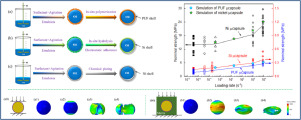Journal of the Mechanics and Physics of Solids ( IF 5.0 ) Pub Date : 2020-03-19 , DOI: 10.1016/j.jmps.2020.103933 Xin Zhang , Pengfei Wang , Dawei Sun , Xin Li , Jinliang An , T.X. Yu , En-Hua Yang , Jinglei Yang

|
Functional materials are widely used by introducing functional microcapsules in the matrix. The individual microcapsule can be regarded as core-shell structure in micro-level. In this study, mechanical performance of individual microcapsule with different shell types (PUF, silica, and nickel) and corresponding microcapsule-modified polymers under quasi-static as well as dynamic compressions are studied experimentally and numerically. Results show that the strength of the nickel shell-based microcapsule is two orders higher than that of the other two microcapsules at different strain rates. More cracks and fragments are observed in microcapsule subject to dynamic loading, which indicates higher energy dissipation under impact. The inclusion of nickel shell-based microcapsule does not cause strength reduction of the resulting microcapsule-modified polymer at all strain rates, while the use of PUF and silica shell-based microcapsules lead to significant reduction of the composites strengths. Nickel shell-based microcapsule-modified polymer shows high strain rate sensitivity than the other two microcapsule-modified polymers. Furthermore, nickel shell-based microcapsule-modified polymer shows distinct failure modes when compared to the PUF and the silica shell-based microcapsule-modified polymers. While matrix cracks tend to penetrate through the weak PUF and silica shell-based microcapsules, they often propagate along the nickel shell-based microcapsule/epoxy matrix interface due to a much higher strength of the nickel shell-based microcapsule. After debonding, sliding of the fracture surfaces may lead to the final fracture of some weaker Ni microcapsules in the nickel shell-based microcapsule-modified polymer.
中文翻译:

单个微胶囊及其聚合物复合材料的动态塑性变形和破坏机理
通过在基质中引入功能性微囊,功能性材料得到了广泛使用。单个微胶囊在微观上可以被视为核-壳结构。在这项研究中,通过实验和数值研究了具有不同壳类型(PUF,二氧化硅和镍)的单个微囊以及相应的微囊改性聚合物在准静态和动态压缩下的力学性能。结果表明,在不同应变速率下,镍壳基微胶囊的强度比其他两个微胶囊的强度高两个数量级。在动态载荷下,微胶囊中观察到更多的裂纹和碎片,这表明在冲击下能量耗散更高。包含镍壳基微囊并不会在所有应变速率下导致所得微囊改性聚合物的强度降低,而PUF和二氧化硅壳基微囊的使用导致复合材料强度显着降低。基于镍壳的微胶囊改性的聚合物比其他两种微胶囊改性的聚合物表现出较高的应变速率敏感性。此外,当与PUF和基于二氧化硅壳的微胶囊改性的聚合物相比时,基于镍壳的微胶囊改性的聚合物表现出不同的破坏模式。尽管基质裂纹倾向于穿透弱的PUF和二氧化硅壳基微囊,但由于镍壳基微囊的强度更高,它们通常沿着镍壳基微囊/环氧树脂基质界面传播。脱胶后











































 京公网安备 11010802027423号
京公网安备 11010802027423号